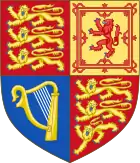Judiciaries of the United Kingdom
The judiciary of the United Kingdom are the separate judiciaries of the three legal systems in England and Wales, Northern Ireland and Scotland. However, the judges of the Supreme Court of the United Kingdom, the Special Immigration Appeals Commission, Employment Tribunals, Employment Appeal Tribunal and the UK tribunals system do have a United Kingdom–wide jurisdiction. In employment law, employment tribunals and the Employment Appeal Tribunal have jurisdiction in the whole of Great Britain (i.e., not in Northern Ireland).
| This article is part of a series on |
| Politics of the United Kingdom |
|---|
.svg.png.webp) |
|
|
Justices of the Supreme Court
The judges of the Supreme Court of the United Kingdom are known as Justices of the Supreme Court, and they are also Privy Counsellors. Justices of the Supreme Court are granted the courtesy title Lord or Lady for life.[1]
The Supreme Court is a relatively new Court being established in October 2009 following the Constitutional Reform Act 2005. Formerly, the Highest Court of Appeal in the United Kingdom was the House of Lords Appellate Committee made up of Lords of Appeal in Ordinary, also known as Law Lords, which with other Lord Justices now form the Supreme Court. It also took over devolution cases from the Judicial Committee of the Privy Council.[2][3] Such Law Lords were allowed to sit in the House of Lords and were members for life.
The Supreme Court serves as the highest court of appeal for all cases in England and Wales and in Northern Ireland, but only for civil cases in Scotland.[4] The High Court of Justiciary remains the court of last resort in Scotland for criminal cases.[5]
The Supreme Court is headed by the President and Deputy President of the Supreme Court and is composed of a further ten Justices of the Supreme Court.
The Justices do not wear any gowns or wigs in court, but on ceremonial occasions they wear black damask gowns with gold lace without a wig.
Tribunal Judiciary
The UK tribunal system is part of the national system of administrative justice with tribunals classed as non-departmental public bodies (NDPBs).[6] Though it has grown up on an ad hoc basis since the beginning of the twentieth century, from 2007 reforms were put in place to build a unified system with recognised judicial authority, routes of appeal and regulatory supervision, and recognised legally qualified members of tribunals as members of the judiciary who are guaranteed continued judicial independence.[7] The UK tribunal system is headed by the Senior President of Tribunals.[8]
See also
References
- "Press release: Courtesy titles for Justices of the Supreme Court" (PDF). Supreme Court of the United Kingdom. 13 December 2010. Retrieved 18 February 2011.
- "Constitutional reform: A Supreme Court for the United Kingdom" (PDF). Department for Constitutional Affairs. Archived from the original (PDF) on 17 January 2009. Retrieved 2 September 2009.
- "Part 3, Constitutional Reform Act 2005". Acts of the Parliament of the United Kingdom. 4. 24 March 2005. p. 3. Retrieved 2 September 2009.
- "Role of the Supreme Court". Supreme Court of the United Kingdom. Retrieved 2 September 2009.
- "Section 40, Part 3, Constitutional Reform Act 2005". Acts of the Parliament of the United Kingdom. 4. 24 March 2005. p. 3(40)(3). Retrieved 2 September 2009.
An appeal lies to the Court from any order or judgment of a court in Scotland if an appeal lay from that court to the House of Lords at or immediately before the commencement of this section.
- Bradley & Ewing (2003) p.292
- Tribunals, Courts and Enforcement Act 2007, s.1, Constitutional Reform Act 2005, s.3
- "Part 1, Tribunals, Courts and Enforcement Act 2007". Acts of the Parliament of the United Kingdom 2007 c.15. 19 July 2007. Retrieved 14 February 2011.
- "Britannica Student Encyclopedia - The Judiciary". Retrieved 9 August 2007.
